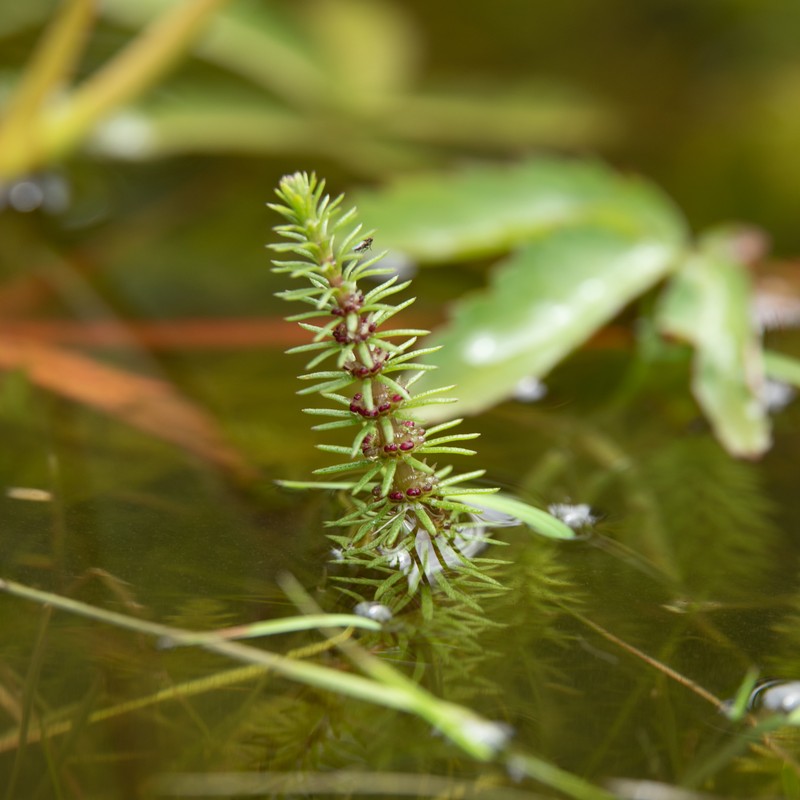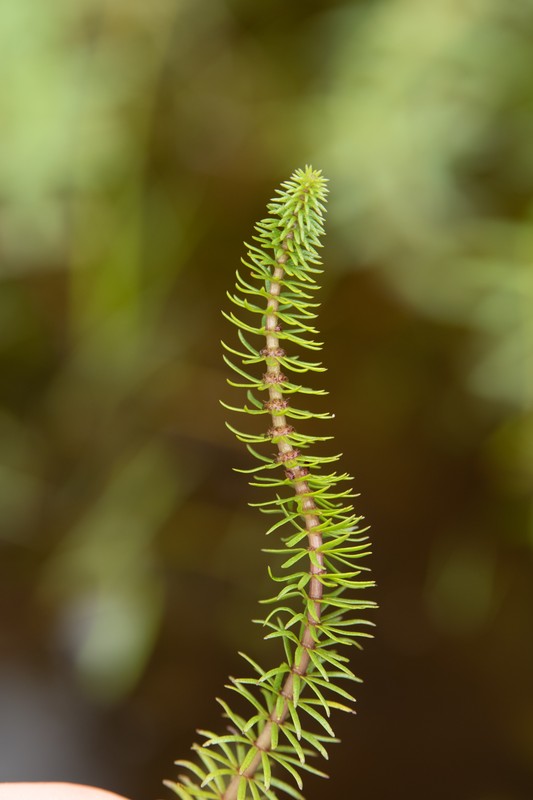Mare's Tail
Hippuris vulgaris L.
- Class
- Dicotyledoneae (Dicots)
- Family
- Plantaginaceae (Plantain Family)
- State Protection
- Endangered
Listed as Endangered by New York State: in imminent danger of extirpation in New York. For animals, taking, importation, transportation, or possession is prohibited, except under license or permit. For plants, removal or damage without the consent of the landowner is prohibited.
- Federal Protection
- Not Listed
- State Conservation Status Rank
- S1
Critically Imperiled in New York - Especially vulnerable to disappearing from New York due to extreme rarity or other factors; typically 5 or fewer populations or locations in New York, very few individuals, very restricted range, very few remaining acres (or miles of stream), and/or very steep declines.
- Global Conservation Status Rank
- G5
Secure globally - Common in the world; widespread and abundant (but may be rare in some parts of its range).
Summary
State Ranking Justification
There is one verified occurrence; about 20 historical occurrences.
Short-term Trends
The short-term threats are unknown.
Long-term Trends
This species has been reduced in number of occurrences from its historical range.
Conservation and Management
Threats
Lake shoreline development is a threat to this species.
Conservation Strategies and Management Practices
Management needs are unknown.
Research Needs
Habitat preferences should be studied.
Habitat
Habitat
The only known, extant site for Common Mare's-tail in New York is a shallow bay with a peaty bottom, where the plants grow along a shoreline of a flooded former bog. Little information is available from the historical sites, which include major rivers, shallow pools, and swamps (New York Natural Heritage Program 2011). Damp shores and shallow water of ponds, lakes, streams, and ditches (Crow and Hellquist 2000). In shallow, quiet water, or seldom on mud (Gleason and Cronquist 1991).
Associated Ecological Communities
- Acidified lake*
The aquatic community of a formerly alkaline lake that has received so much acid deposition (pH less than 4.7; sulfate and nitrate are now the dominant anions in precipitation in the Northeast) that the pH of the lake has decreased significantly.
- Bog lake/pond*
(guide)
the aquatic community of a dystrophic lake that typically occurs in a small, shallow basin (e.g., a kettehole) that is protected from wind and is poorly drained. These lakes occur in areas with non-calcareous bedrock or glacial till; many are fringed or surrounded by a floating mat of vegetation (in New York usually either bog or poor fen).
- Deepwater river
The aquatic community of very large, very deep, quiet, base level sections of streams with a very low gradient. In places the water is deep enough so that light cannot reach the river bottom.
- Eutrophic dimictic lake*
(guide)
The aquatic community of a nutrient-rich lake that occurs in a broad, shallow basin. These lakes are dimictic: they have two periods of mixing or turnover (spring and fall); they are thermally stratified in the summer, and they freeze over and become inversely stratified in the winter.
- Mesotrophic dimictic lake*
(guide)
The aquatic community of a lake that is intermediate between an oligotrophic lake and a eutrophic lake. These lakes are dimictic: they have two periods of mixing or turnover (spring and fall); they are thermally stratified in the summer, and they freeze over and become inversely stratified in the winter.
- Oligotrophic dimictic lake*
(guide)
The aquatic community of a nutrient-poor lake that typically occurs in a deep, steeply-banked basin. These lakes are dimictic: they have two periods of mixing or turnover (spring and fall), they are thermally stratified in the summer, and they freeze over and become inversely stratified in the winter.
- Oligotrophic pond*
(guide)
The aquatic community of a small, shallow, nutrient-poor pond. The water is very clear, and the bottom is usually sandy or rocky.
- Oxbow lake/pond*
(guide)
The aquatic community of a small, shallow, usually stagnant lake or pond of fluvial origin that occurs in an old river meander or oxbow that has been cut off from an unconfined river or marsh headwater stream by deposition of a levee. Typically, the associated river periodically overflows this levee, restoring river water and biota to this lake type.
- Reservoir/artificial impoundment*
The aquatic community of an artificial lake created by the impoundment of a river with a dam. Reservoirs are constructed to collect water for municipal and/or agricultural water use, to provide hydroelectric power, and to improve opportunities for recreational activities (e.g., boating, swimming), and development.
- Unconfined river*
(guide)
The aquatic community of large, quiet, base level sections of streams with a very low gradient.
* probable association but not confirmed.
Associated Species
- Bidens beckii (Beck's water-marigold)
- Ceratophyllum
- Eleocharis robbinsii (Robbins's spike-rush)
- Najas
- Nuphar
- Nymphaea
- Pontederia cordata (pickerelweed)
- Potamogeton
- Schoenoplectus subterminalis (water bulrush)
- Utricularia intermedia (flat-leaved bladderwort)
- Vallisneria americana (water-celery, tape-grass)
Range
New York State Distribution
Hippuris vulgaris is currently extant in Franklin, Essex, Lewis, and St. Lawrence County and historically known from Seneca and Washington County
Global Distribution
Mare's tail is found throughout the western US and along the northern tier of states in the central US. It extends east from Michigan where it becomes rare from New York through Vermont and New Hampshire to Maine. North of the US it is circumpolar in Canada, Europe and Asia.
Identification Comments
General Description
Mare's tail has a soft but stiffly erect stem that is unbranched and about 2-6 decimeters tall. The whorls of leaves that are out of the water are numerous and crowded, with widely spreading linear leaves that are thick and firm and 1-3 cm long by 1-3 mm wide. The flowers and fruits are sessile just above the each leaf. The submersed stems have longer internodes and lax leaves.
Identifying Characteristics
Mare's tail has a soft but stiffly erect stem that is unbranched and about 2-6 decimeters tall. The whorls of leaves that are out of the water are numerous and crowded, with widely spreading linear leaves that are thick and firm and 1-3 cm long by 1-3 mm wide. The flowers and fruits are sessile just above the each leaf. The submersed stems have longer internodes and lax leaves.
Best Life Stage for Proper Identification
Mare's tail can be identified in the vegetative stage with or without flowers and fruits.
Similar Species
Young stands of horsetail may be mistaken for mare's tail but no other emergent plant looks like it.
Best Time to See
Common Mare's-tail has inconspicuous flowers, so it can be detected equally well whenever its leaves are emergent, from July until first frost.
- Vegetative
- Flowering
- Fruiting
The time of year you would expect to find Mare's Tail vegetative, flowering, and fruiting in New York.
Mare's Tail Images
Taxonomy
Mare's Tail
Hippuris vulgaris L.
- Kingdom Plantae
- Phylum Anthophyta
- Class Dicotyledoneae
(Dicots)
- Order Plantaginales
- Family Plantaginaceae (Plantain Family)
- Order Plantaginales
- Class Dicotyledoneae
(Dicots)
- Phylum Anthophyta
Additional Common Names
- Mare's-tail
Additional Resources
References
Gleason, Henry A. and A. Cronquist. 1991. Manual of Vascular Plants of Northeastern United States and Adjacent Canada. The New York Botanical Garden, Bronx, New York. 910 pp.
Holmgren, Noel. 1998. The Illustrated Companion to Gleason and Cronquist's Manual. Illustrations of the Vascular Plants of Northeastern United States and Adjacent Canada. The New York Botanical Garden, Bronx, New York.
New York Natural Heritage Program. 2024. New York Natural Heritage Program Databases. Albany, NY.
Weldy, T. and D. Werier. 2010. New York flora atlas. [S.M. Landry, K.N. Campbell, and L.D. Mabe (original application development), Florida Center for Community Design and Research http://www.fccdr.usf.edu/. University of South Florida http://www.usf.edu/]. New York Flora Association http://newyork.plantatlas.usf.edu/, Albany, New York
Links
About This Guide
Information for this guide was last updated on: February 1, 2023
Please cite this page as:
New York Natural Heritage Program. 2024.
Online Conservation Guide for
Hippuris vulgaris.
Available from: https://guides.nynhp.org/mares-tail/.
Accessed July 27, 2024.


